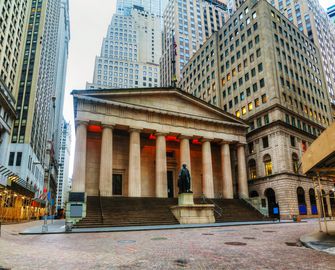

The building that we see today was constructed in the middle of 19th century in the classical style as the United States Customs House. It later became one of America's Sub-Treasury locations and in 1939 was transformed into the national memorial. The bronze statue of George Washington, created by sculptor John Quincy Adams Ward in 1883, shows the great revolutionary leader placing his hand on the bible (although the book is not included in the sculptural composition) as he is taking the oath to become America's first president.
In fact, it was on this exact spot, precisely where the statue stands today, that George Washington became president of the newly founded country on April 30, 1789. The ceremony took place on the balcony of the original Federal Hall that had been built in 1700.
City Hall had already played an important role before the American Revolution when in 1765 delegates from the 13 colonies met inside the building to protest the Stamp Act, a tax levied by the British Parliament on all the colonies of British America. The Stamp Act Congress, as the meeting in City Hall became known, demanded that Great Britain repeal the tax because the colonies did not have any representation in British Parliament. The strong opposition frightened British merchants and eventually the act was repealed.
After the revolution, City Hall was the seat of the Congress of the Confederation, the governing body that administered the 13 colonies while they were still a confederation of sovereign states. By the time George Washington took his presidential oath, the building had been enlarged by French architect Pierre Charles L'Enfant, who had come to America and fought under Washington during the American Revolutionary War. When the new constitution was adopted in 1789, Federal Hall housed the First United States Congress, which ratified one of the most important documents in modern history: the Bill of Rights. The Bill of Rights, otherwise known as the first ten amendments to the constitution, guaranteed fundamental human rights such as freedom of speech, religion, assembly and press. It also limited the power of the federal government and gave the average citizen more leverage in the court.
The building that witnessed all these great events during the foundation of American society was demolished in 1812 and was substituted 30 years later with the edifice that stands today.
Inside, the Federal Hall National Memorial contains a series of very important artifacts. Among them the visitor can find the original bible on which George Washington took his inaugural oath and the original photograph of the 1920 Wall Street bombing which occurred right in front of the memorial. It was organized by anti-capitalist anarchists and, by taking the lives of 38 people, became the first major terrorist act to be carried out on American soil.